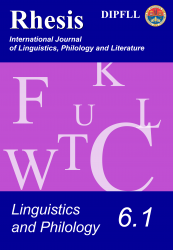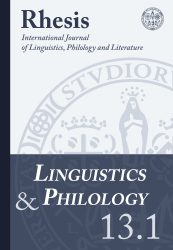 Linguistics and Philology
Linguistics and PhilologyVol. 6.1 - 2015
Download issue
Table of contents
| p. 5 | Marred in transmission? A new proposal for the questioning sequence in the Old Norse SvipdagsmálGiorgio BasciuAbstract The Old Norse Svipdagsmál is a composite piece of eddic poetry which comprises two complementary poems, Grógaldr and Fiǫlsvinnzmál. These two poems date to the 13th century, but they are only preserved in late paper manuscripts (17th-19th century). The text transmitted in the manuscripts shows several signs of corruption, and many aspects of its form and content have been subject to debate. Among other concerns, some incongruities have been pointed out regarding the progression of the core section of Fiǫlsvinnzmál (sts 7-42). Möller (1875) attempted to resolve these apparent structural anomalies by revising the arrangement of twelve stanzas (sts 13-24). Through a detailed structural analysis of the poem, this article shows that Möller’s proposal is not entirely satisfactory, and proposes a new arrangement of stanzas 9 to 40 which removes the oddities inherent in the original sequence. The structure of the rearranged sequence follows a neat and plausible pattern and appears quite consistent with the poet’s taste for symmetry and numerological references which is apparent throughout the poem.
|
| p. 16 | Cronache monastiche e alfabetizzazione femminile a Roma nella prima età moderna: percorsi di analisi linguisticaRita FresuAbstract The paper aims at starting a linguistic reflection on the text type of female monastic chronicle in the XVII-XVIII centuries. The analysis takes into consideration two important Roman chronicles, the Book of Antiquities of the monastery of San Cosimato, written in double draft early in the Seventeenth century by the Roman Poor Clare Sister Orsola Formicini (abt. 1548-1613), and the first book of the Chronicle of Benedictine convent of St. Cecilia in Rome, compiled between 1610 and 1710 by four different nuns. The examination of some specimina of such texts has been conducted with the intention of redefining the writing competence of these writers (regardless of their socio-cultural status) on the basis of some parameters such as their ability to control the dialect interference, to maintain a syntactic-textual structure coherent and cohesive (away from the mechanisms of the speech), in compliance with the stylistic elements typical of the chronicle genre.
|
| p. 37 | Elementi medio-arabi nel nucleo egiziano della Sīrat BaybarsAngela Daiana LangoneAbstract Baybars, a Mamluk sultan that ruled in Syria and Egypt in the second half of the XIII century, is one of the most celebrated figures in the Arab culture and his legendary personage inspired a series of epic narratives that constitute the so called Sīrat Baybars. Often considered as a genre belonging to the Arabic literature composed during the medieval period of the decadence, the Sīrat Baybars shows interferences of the dialect(s) spoken by its unknown author(s) within the literary Arabic text. This paper deals with the detection of some of the interferences, i.e. its Middle Arabic features, that are recognizable in the Egyptian nucleus of the Sīrat Baybars.
|
Tags: Angela Daiana Langone, Arabic dialectology, chronicle, eddic, Egyptian Arabic, female religious writing, fréttatal, Giorgio Basciu, language and Church, Levantine Arabic, Middle Arabic, Old Norse, Rita Fresu, Roman dialect, Seventeenth century, Sīrat Baybars, stanza order, Svipdagsmál
 Linguistics and PhilologyVol. 6.1 - 2015
Linguistics and PhilologyVol. 6.1 - 2015
